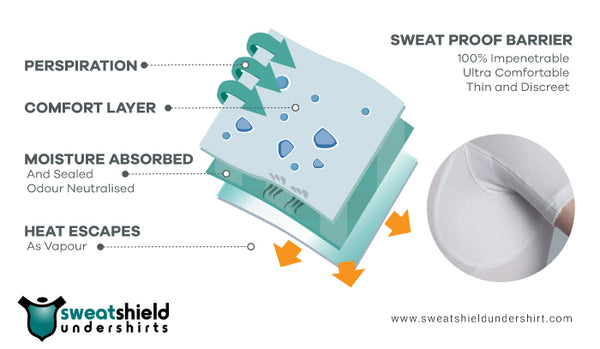Diaphoresis is a condition that makes you sweat excessively for no apparent reason.
If you've found yourself sweating profusely for some time, you may feel like you're the only one.
This can lead you to wonder why you sweat more than others, but in fact, you're not alone.
Anyone else here have a problem with excessive sweating? from r/AskWomen
This type of sweating may be the result of a natural life event, such as menopause or allergic reaction, or an underlying medical condition, like diabetes.
It's important to note that ideally, sweating is a normal and healthy process. It is the natural way in which our bodies control our temperature.
When your body detects an increase in temperature, the hypothalamus sends a signal to the sweat glands for them to produce sweat.
Physical exertion and exposure to heat are common reasons why we sweat. Stress and anxiety can also be causal factors.
Sweat serves as a coolant, keeping our bodies from overheating as this can cause damage to our organs.
In other cases, sweating may occur in the armpits or on the palms because of emotional or mental stress.
If you experience excessive sweating for some time, clothes may start to yellow due to sweat stains.
The way to relieve diaphoresis is by establishing the underlying cause.
Read on to understand the possible causes and treatment options available for diaphoresis, how to manage the condition, and the benefits of wearing sweat-proof clothing.

A sweat-proof undershirt from Sweatshield.
Causes of Diaphoresis
Hyperthyroidism
Hyperthyroidism is a condition that causes the thyroid gland to produce too much thyroxine.
Thyroxine is a hormone that helps regulate the body’s metabolism. Excess thyroxine is highly likely to speed up your metabolism, causing excessive sweating.
If you have hyperthyroidism, you may also experience:
- Insomnia
- Weight loss
- Nervousness
- A rapid heartbeat and racing pulse
- Shaky hands
If you suspect that you may have hyperthyroidism, seek a doctor's opinion to be sure.
Diabetes
People with diabetes may experience excessive sweating.
This could be an indication of hypoglycemia (low blood sugar).
Hypoglycemia requires urgent intervention, as it can cause severe complications and is life-threatening.
Other than profuse sweating, additional signs of hypoglycemia include:
- Slurred speech
- Dizziness
- Loss of vision
- Anxiety
- Shaking
Menopause
It's quite common for many women to sweat heavily, once they start to experience menopause.
Happening mostly during the night, hormones (such as estrogen) send signals to the brain that the body is overheating even at times when it isn't and as a result, the hypothalamus triggers sweat production.
Pregnancy
Pregnancy may often be accompanied by hormone fluctuations and weight gain.
These can cause expectant women to sweat more than usual.
In fact, many women sweat more during their pregnancy compared to any other time throughout their lives.
Sweating during pregnancy can also be attributed to increased metabolism.
While sweating during pregnancy is normal, it could also be a cause for concern. It's important to see a doctor if excessive sweating is accompanied by:
- Fever
- Vomiting
- Chills
These symptoms could indicate infection or another condition that needs to be diagnosed and treated.
Withdrawal Side Effects
Ceasing the recreational use of alcohol or drugs can send someone into withdrawal.
Of the numerous symptoms and effects of withdrawal, profuse sweating is quite common.
Other likely symptoms include:
- Fluctuations in blood pressure
- Agitation and anxiety
- Tremors
- Seizures
- Nausea or vomiting
Someone experiencing withdrawal should seek medical care to help manage the condition.
Medications
If you're on medication, it's possible for you to sweat more than usual.
Some over-the-counter and prescription drugs that may cause diaphoresis include:
- Some antibiotics
- Certain antivirals
- Pain relief
- Hormonal medications
- Chemotherapy medication
Anaphylaxis and certain cancers can also bring about diaphoresis.
How Is Diaphoresis Treated?
There are various treatment options available for diaphoresis which vary depending on the cause.
In many instances, dealing with the underlying condition puts a stop to excessive sweating.
The following are treatment options for diaphoresis:

An iontophoresis procedure to treat excessive palm sweating- Image: DermNet New Zealand
If medication is diagnosed as the cause, your doctor may prescribe an alternative. In the event this isn't possible, you can still find ways to manage the sweating.
For instance, by using a strong underarm antiperspirant if this is the area diaphoresis affects.
All the same, don't despair if your antiperspirant doesn't seem to work.
Here's what to do:
- Switch up your freshness routine. Take a shower and use antiperspirant at night, as recommended by dermatologists. This could have better results than using an antiperspirant in the morning.
- Experiment. Different types of antiperspirant work differently for many people, so don't give up just yet.
- Go for antibacterial soap and try natural alternatives to aluminum-based antiperspirants. More and more people are conscious about using less harsh products on their bodies. Give it a try and see if it works for you.
- Try a sweat guard.
It's important to seek your dermatologist's advice on this, to ensure that the products you use won't have negative effects.
Is Diaphoresis Preventable?
While there's no absolute guarantee of preventing diaphoresis, you can still reduce the chances of the condition affecting you.
You can do this by:
- Increasing your water consumption.
- Eating a balanced diet as often as you can.
- Managing diabetes.
- Maintaining a healthy body weight.
- Exercising on a regular basis.
- Wearing sweat-proof clothing.
When should you see a doctor?
If you begin to experience excessive sweating out of nowhere and can't single out why this is happening, you should see a doctor.
Likewise, if you get a rash lasting for more than a few days, it may be a cause for concern and could indicate a skin infection.
It's also important to seek medical advice if you experience excessive sweating accompanied by:
- Chest pains
- Loss of consciousness
- Seizures
- Heart palpitations
- Breathing difficulties
- Dizziness
- Nausea
- Pale, cold, clammy skin
Once you start treatment, the results won't be immediate. As you wait, it's important to find ways to manage the condition.
One way to do this is to wear sweat-proof clothing.
How Does Sweat-Proof Clothing Work?
Sweat-proof clothing undergoes special processes and features innovative design. This is all geared to prevent it from trapping sweat on your skin.
The fabrics used are more breathable compared to those used in regular clothing.
This means that they let your skin breathe by allowing heat and sweat (in vapor form) to escape from the surface of your skin.
You'll notice a big difference in the level of comfort Sweatshield clothing offers over cotton and other sweat-proof clothes.
While it's common to use cotton thanks to its breathable and absorbent qualities, Sweatshield undershirts use an even better fabric - micromodal.
Micromodal gives our undershirts a smooth, luxurious silky feel.
Better yet, it checks all the boxes - micromodal is sustainable, durable and flexible.
It's no wonder that micromodal fabric is the material of choice for many activewear brands. Micromodal takes the heat (and the sweat) better than other fabrics.
Sweatshield is further set apart by its sweat barrier technology.
As a result, many people from around the world have been able to manage their excessive sweating.
This has made Sweatshield a trusted, dependable and highly rated solution for over 10 years now.
Stay dry and fresh with Sweatshield Undershirts, available in a range of styles for both men and women.
Photo: Kullez










